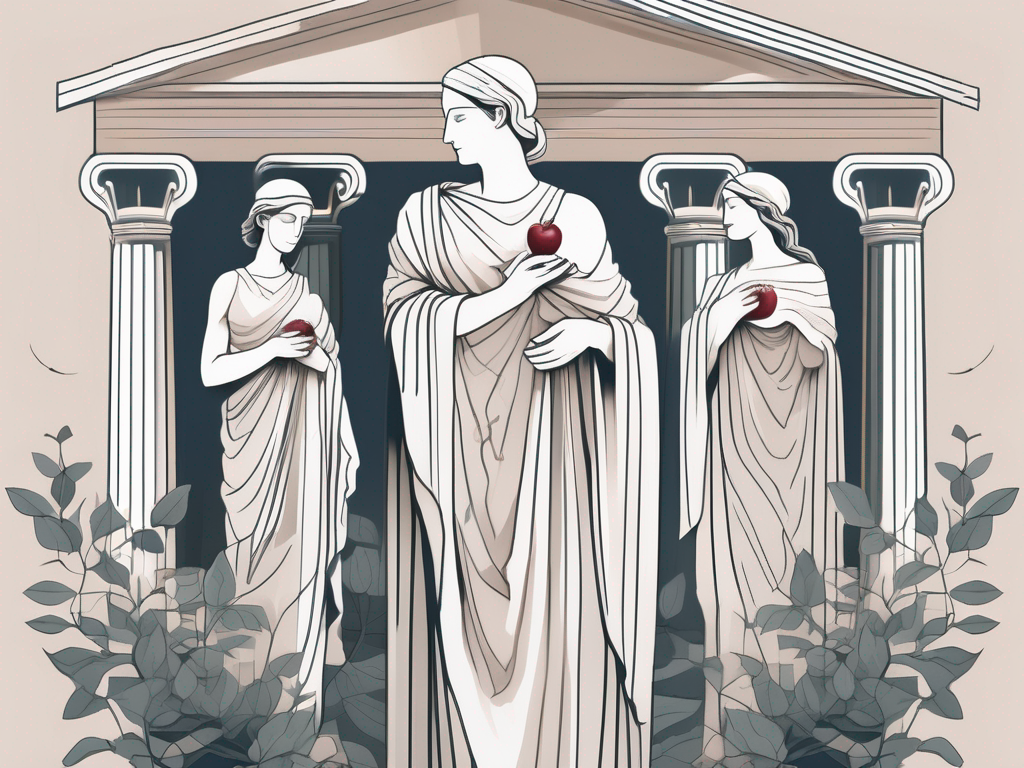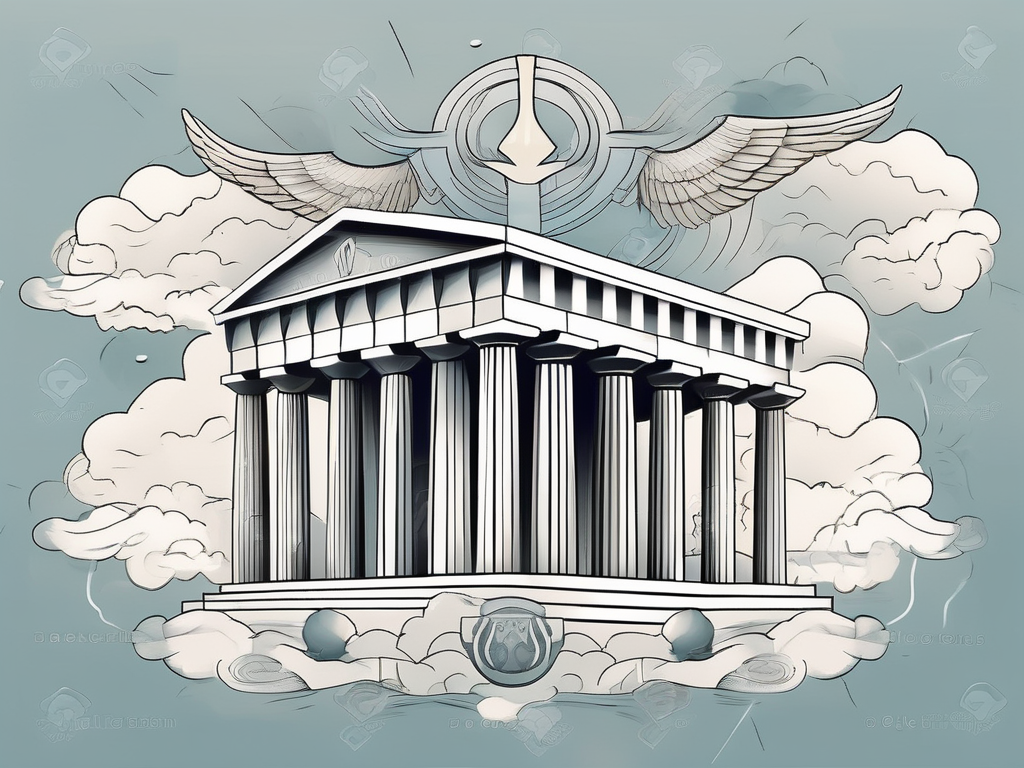Greek mythology is filled with captivating tales of gods and goddesses, and among these enchanting figures are the Graces. These divine beings are known for their beauty, charm, and gracefulness. In this article, we will delve into the mythology surrounding the Graces, explore their individual profiles, examine their significance in art and literature, and consider their relationships with other deities. Join us as we unveil the secrets of these mesmerizing Greek goddesses.
Understanding the Mythology of the Graces
Before we dive into the captivating world of the Graces, let’s first understand the mythology surrounding them. The Graces, also known as the Charites, are goddesses who personify grace, beauty, and charm. They are often depicted as three sisters, daughters of Zeus and the Oceanid Eurynome.
Legend has it that the birth of the Graces was a moment of divine beauty and joy. As Zeus, the king of the gods, united with Eurynome, a nymph of the sea, the heavens rejoiced. The union of these two powerful beings brought forth the radiant goddesses, who were destined to bring joy and beauty to the world.
The Origin of the Graces in Greek Mythology
In Greek mythology, the Graces are said to have emerged from the union of Zeus and Eurynome. These radiant goddesses were born to bring joy and beauty to the world. According to some accounts, they resided on Mount Olympus, the abode of the gods.
Mount Olympus, the majestic peak that pierced the sky, was the dwelling place of the gods and goddesses. It was a realm of divine splendor, where the Graces reveled in their ethereal existence. Surrounded by the celestial beauty of the heavens, they embodied the essence of grace, captivating all who beheld them.
The Role and Influence of the Graces
The Graces played a significant role in Greek culture. They were believed to bestow charm and grace upon humans and gods alike. These goddesses were known to inspire artists, musicians, and poets, infusing their creations with beauty and elegance. They were also associated with fertility, ensuring the abundance of nature’s bounties.
Artists sought the favor of the Graces, hoping to capture their essence in their masterpieces. Musicians composed melodies that echoed the harmonious nature of these divine beings. Poets weaved words together, guided by the graceful touch of the Graces, creating verses that resonated with the hearts of mortals.
Not only were the Graces patrons of the arts, but they also played a role in the realm of love and desire. They were believed to bless unions and ensure the success of marriages. Their presence at weddings was seen as a sign of good fortune, a promise of everlasting love and happiness.
Furthermore, the Graces were closely associated with fertility and the abundance of nature. They were believed to bless the earth with their gentle touch, ensuring the growth of crops and the flourishing of flora and fauna. Their presence in the fields was seen as a harbinger of a bountiful harvest, a testament to their nurturing and life-giving qualities.
The mythology of the Graces is a testament to the importance of grace, beauty, and charm in Greek culture. Their influence extended beyond the realm of the gods, touching the lives of mortals and leaving an indelible mark on the arts, love, and the abundance of nature. The Graces continue to inspire and captivate, reminding us of the enduring power of beauty and elegance in our lives.
Individual Profiles of the Three Graces
Now that we have a general understanding of the Graces, let’s take a closer look at each of these captivating goddesses and their unique attributes.
Aglaea: The Grace of Beauty and Splendor
Aglaea, one of the Graces, represents beauty and splendor. She is often depicted wearing a crown of laurel leaves and adorning elegant garments. Aglaea’s presence brings forth an aura of radiance and charm, captivating all who encounter her.
Aglaea’s beauty is not just limited to her physical appearance. It is said that her inner beauty shines just as brightly as her outward radiance. Her grace and elegance are reflected in every movement she makes, as if she is dancing with the very essence of beauty itself.
Those who have been fortunate enough to witness Aglaea in all her splendor describe her as a vision of perfection. Her flawless features, mesmerizing eyes, and enchanting smile leave an indelible mark on the hearts of those who behold her.
Euphrosyne: The Grace of Mirth and Joyfulness
Euphrosyne embodies mirth and joyfulness. Her infectious laughter and lighthearted demeanor are said to fill hearts with happiness. Euphrosyne is often portrayed with a joyous smile and rosy cheeks, radiating an aura of cheerfulness.
When Euphrosyne enters a room, it is as if the sun has come out from behind the clouds, illuminating everything with warmth and light. Her laughter is like a sweet melody, lifting spirits and bringing smiles to even the most somber faces.
Euphrosyne’s joyfulness is contagious, spreading like wildfire among those in her presence. She has the remarkable ability to find humor and joy in even the simplest of things, reminding us all to cherish the little moments that bring happiness to our lives.
Thalia: The Grace of Good Cheer and Festivity
Thalia represents good cheer and festivity. She is known for her jovial nature and love for celebration. Thalia is often depicted holding a trumpet, symbolizing revelry and merriment. Her presence brings forth a sense of joy and excitement.
Thalia’s laughter is like the sound of a thousand bells ringing in unison, announcing the arrival of happiness and celebration. Her infectious energy fills the air, making even the most mundane gatherings come alive with laughter and merriment.
When Thalia is present, it is impossible not to feel a surge of excitement and anticipation. She has the uncanny ability to turn any gathering into a memorable event, leaving everyone with cherished memories and a longing for more festive occasions.
The Graces in Art and Literature
The timeless beauty and charm of the Graces have inspired countless artists and writers throughout history. Let’s explore how these goddesses have been depicted in both ancient art and classical literature.
The Graces, also known as the Charites in Greek mythology, were three goddesses who personified beauty, charm, and grace. They were daughters of Zeus and Eurynome, and their names were Aglaea, Euphrosyne, and Thalia. These divine beings were believed to bestow blessings upon mortals, bringing joy and harmony to the world.
Depictions of the Graces in Ancient Art
In ancient art, the Graces were often portrayed in graceful poses, dressed in flowing garments that accentuated their beauty. Sculptors and painters captured their allure, emphasizing their elegance and charm. The artists skillfully depicted the Graces with gentle smiles, radiant eyes, and flowing hair, symbolizing their ethereal nature.
One famous representation of the Graces is the marble relief known as “The Three Graces” by Antonio Canova. Created in the early 19th century, this sculpture showcases the Graces in a delicate embrace, their bodies intertwined in a harmonious dance. The intricate details of their drapery and the expressions on their faces convey a sense of serenity and grace.
Another notable portrayal of the Graces can be found in ancient Greek pottery. These vessels often featured intricate black-figure or red-figure paintings, depicting the Graces in various scenes. They were shown dancing, playing musical instruments, or adorning themselves with flowers, symbolizing their association with joy, celebration, and fertility.
These representations serve as a testament to the Graces’ lasting influence on Greek art. Their depiction in different mediums showcases the artists’ admiration for their beauty and their desire to capture their essence for eternity.
The Graces in Classical Literature
The Graces also found their place in classical literature. Poets and writers often referenced these goddesses, praising their gracefulness and beauty. The ancient Greek poet Hesiod described the Graces as “charming, lovely, and golden-haired,” highlighting their enchanting qualities.
In Greek mythology, the Graces were closely associated with the Muses, the goddesses of inspiration. They were believed to accompany the Muses, adding an extra layer of elegance and charm to the creative process. Their presence in literary works continues to captivate readers, evoking a sense of enchantment and admiration.
One of the most famous references to the Graces can be found in Homer’s epic poem, “The Iliad.” In this ancient masterpiece, the Graces are mentioned as attendants of Aphrodite, the goddess of love. Their presence in the narrative adds a touch of divine beauty and harmony to the tumultuous world of the Trojan War.
Furthermore, the Graces were often invoked by poets and writers to inspire their own works. They were seen as muses themselves, capable of bestowing artistic talent and creativity upon mortals. Their ethereal presence in literature serves as a reminder of the enduring power of beauty and grace.
In conclusion, the Graces have left an indelible mark on both art and literature. Their timeless beauty and charm continue to inspire and captivate audiences across the centuries. From their graceful depictions in ancient art to their enchanting presence in classical literature, the Graces remain a symbol of elegance, harmony, and the enduring power of beauty.
The Graces and Their Relationship with Other Deities
As with most Greek gods and goddesses, the Graces had connections with other deities. Let’s explore the divine relationships they shared with two prominent figures.
The Graces and Aphrodite: A Divine Connection
The Graces shared a close bond with Aphrodite, the goddess of love and beauty. Together, they formed a divine trio that embodied love, beauty, and charm. The Graces were often depicted accompanying Aphrodite, reinforcing the goddess’s allure and enhancing her irresistible charm.
The Graces and Zeus: A Powerful Alliance
Being daughters of Zeus, the king of gods, the Graces held a special place in the realm of Mount Olympus. Their influence extended beyond their association with other deities. Their presence symbolized the power and prestige of Zeus, solidifying their position as revered goddesses in Greek mythology.
The Modern Interpretation and Influence of the Graces
The allure of the Graces continues to captivate the modern world. Their timeless beauty and grace have left an indelible mark on contemporary culture.
The Graces in Contemporary Culture
In today’s society, the Graces serve as a symbol of grace and elegance. Their influence can be seen in fashion, art, and entertainment. The concept of embodying the grace and charm of the Graces is embraced by individuals who seek to exude beauty and elegance in their daily lives.
The Graces as Symbols of Grace and Charm Today
The Graces’ legacy lives on as a reminder of the enduring power of grace and charm. In a world that sometimes feels chaotic, the values they represent offer solace and inspiration. The Graces remind us to embrace our inner beauty, cultivate elegance, and strive to bring joy and grace to the world around us.
As we conclude our journey into the enchanting world of the Graces, we hope you now have a deeper appreciation for these mesmerizing Greek goddesses. Their timeless beauty, grace, and charm continue to captivate the hearts and imaginations of people around the world. The Graces remind us of the importance of embracing our inner beauty and spreading grace and charm in our lives.












